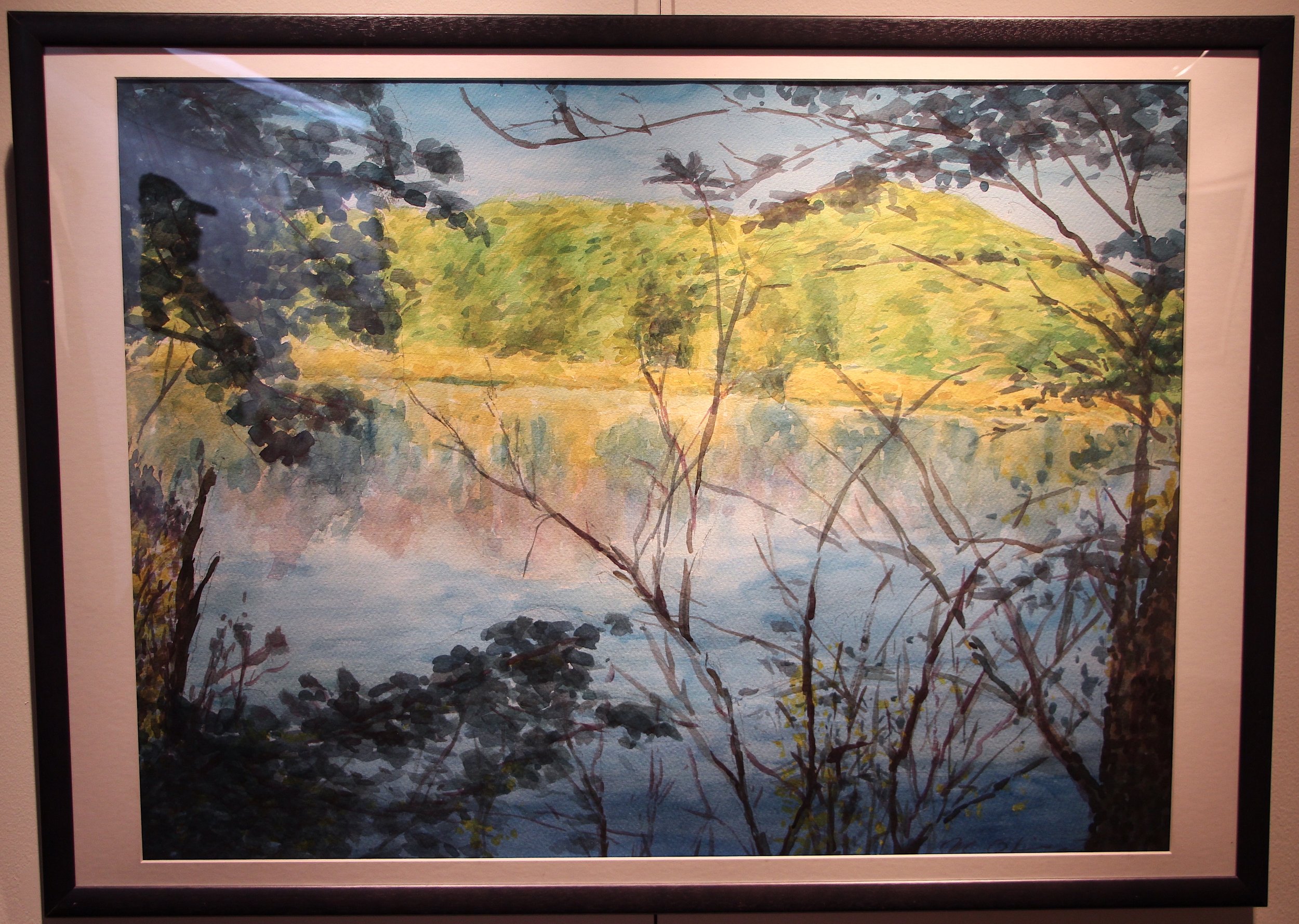City College's Cohen Library welcomes Makoto Obinata’s art
By Anastasia Kasper
Photos by Sophie Powers
Goshikinuma Pond, end of summer. Photo: Sophie Power, The Campus photographer
A watercolor painting of a peaceful, crystal-blue river embraced from both sides by green Japanese mountains expresses the untamed expansiveness of nature and the feeling of calmness it evokes in the viewer. The landscape depicts an early morning in the vast wilderness, its tranquility, but also the overwhelming sensation that makes a person feel small while facing an enormous mountain. The skillfully applied chiaroscuro (the treatment of light and shade in drawing and painting) allows the observer to fully notice the depth and vastness of this Japanese valley that Obinata captures in his painting. On the opposite wall, however, we see a vibrant, colorful scene from Tokyo’s Asakusa Tanabata Festival. The narrow street, bathed in intricate bamboo decorations (fukinagashi) resonates with its artistic energy and vigor. Similar to the mountains embracing the valley in the other painting, here lively decorated houses rim the pathway leading straight to the Tokyo Tower. In his works, Makoto Obinata strives to capture this duality of nature, the fast-paced life of a city versus the peace and quiet of the wilderness. The twelve works of Obinata form a small show called Makoto Obinata - Distant Journey in a special exhibition on the fifth floor of the Cohen Library. It is the Japanese artist’s first solo exhibition in New York City.
Obinata, well-known in his native Japan, uses watercolor technique to create his cutting-edge art. He applies colorful pigments with a brush, and water lets the colors soak into the canvas. Obinata acquired this technique, alongside many others, at the University of Tokyo, where he majored in art to further develop his innate artistic capabilities. “He has been painting since he was a student and gradually incorporating expressions of light into his works,” mentions Hideo Nakamura, the exhibition’s organizer and Obinata’s friend. He went on to say, “In recent years, we have also seen works that focus more on the depiction of people and artifacts, and his expressions are becoming more detail-oriented.” This attentiveness to the details shows in the watercolor of bright red apples lying below what appears to be a portrait of workers sitting at a table. What struck me the most about this painting was that it is the only painting of still life that makes a part of the exhibition. Being curious about this work, I asked Mr. Nakamura if including only one still life piece in the exhibition that contains mostly landscapes served to carry any special message. “Until now, he has mostly focused on nature and landscapes, but he painted this work at his home as a change of pace to look at more familiar scenery,” commented Nakamura.
When asked about Obinata’s intentions behind his work, Nakamura said, “I think he shares with people the beauty and emotion of the landscapes he has visited and felt at the time.” This exhibit, expanded with other paintings, will be shown in Obinata’s hometown of Nagano next April. The works of Obinata capture the fleeting beauty of nature as they transcend their seemingly lighthearted and carefree spirituality. His art evokes deep nostalgia that we feel towards places we find ourselves in daily. Whether we choose to admire the golden leaves falling on the background of Tokyo buildings in Autumn on National Route I or reflect upon the changing seasons while looking at the landscape of a winter forest in Shimokita Peninsula, one is certain: Obinata makes us pause and pay closer attention to the beauty of the ordinary. Nakamura revealed to me that Obinata describes his approach to the work as follows; "I make sketches on site, draw a rough sketch on a piece of drawing paper, apply a thin layer of color to the entire piece, and then move on to the details. Then, I start to draw in the details,” he wrote.
He also offered advice to students and others who hope to portray what they see in their world. “It is important to draw what you see and feel directly and honestly from your heart. I want you to draw what you feel at the time, without being bound by existing forms. Don't worry if you can't draw what you want to draw well, everyone feels differently, and I believe that bringing out what is inside you as it is will lead to the individuality of your work.”
The exhibit was in the Cohen Library until October 20. Another Japanese artist, Mitate, is having an exhibition titled unconscious formation through November 3, 2023, in the Cohen Library Archives Gallery. Obinata will have a larger show that will take place in Tribeca's “One Art Space” gallery in May 2024.




